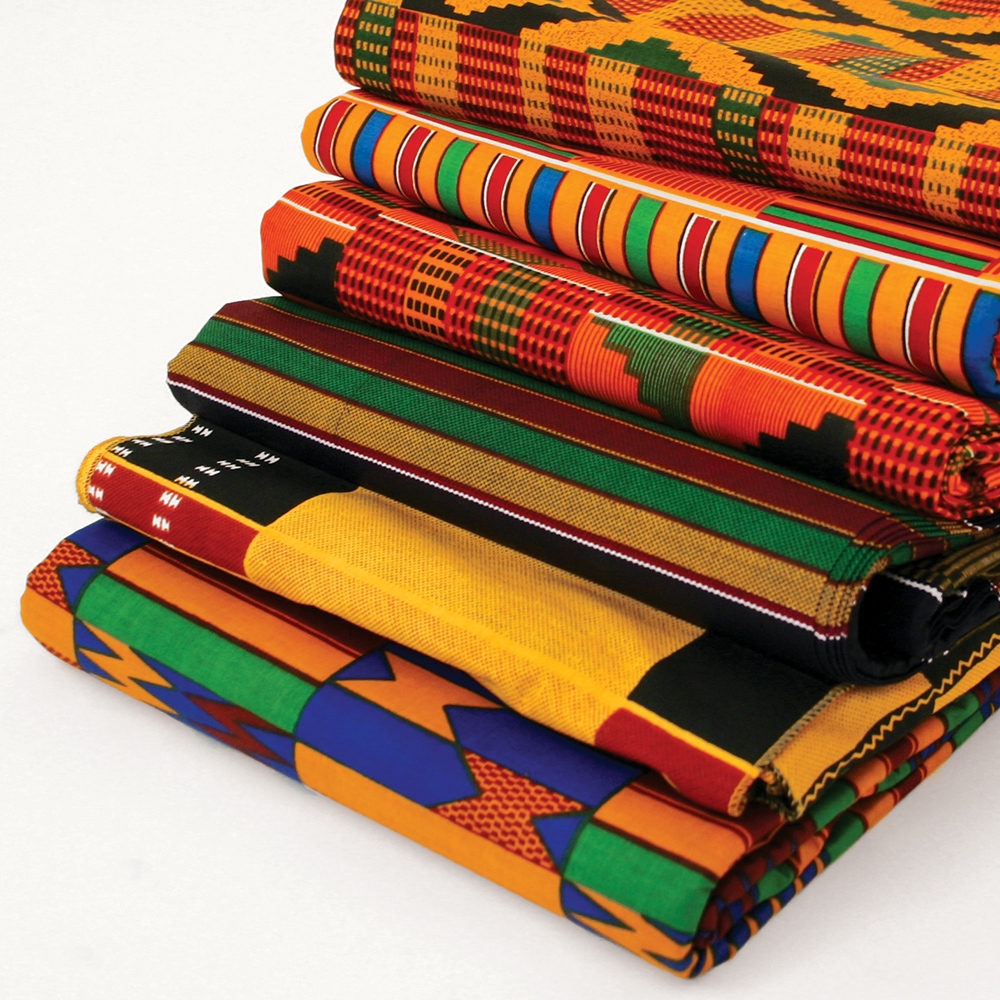Its meaning, history, and how to get yours

Order online now or call 201-457-1995 for the benefits of kente cloth for yourself!
I am loving the fabrics just purchased. Everything is beautiful as always.
- Amanda in San Diego, CAAbsolutely Beautiful. I love the different African fabrics. Yes, they do look more expensive than the price.
- Latisha from Michigan
What do the Kente designs mean
Symbolic meanings of the colors in African Kente cloth:
- Black kente cloth-- maturation, intensified spiritual energy
- Blue kente cloth-- peacefulness, harmony and love
- Green kente cloth-- vegetation, planting, harvesting, growth, spiritual renewal
- Gold kente cloth-- royalty, wealth, high status, glory, spiritual purity
- Grey kente cloth-- healing and cleansing rituals; associated with ash
- Maroon kente cloth-- the color of mother earth; associated with healing
- Pink kente cloth-- associated with the female essence of life; a mild, gentle aspect of red
- Purple kente cloth-- associated with feminine aspects of life; usually worn by women
- Red kente cloth-- political and spiritual moods; bloodshed; sacrificial rites and death.
- Silver kente cloth-- serenity, purity, joy; associated with the moon
- White kente cloth-- purification, sanctification rites and festive occasions
- Yellow kente cloth-- preciousness, royalty, wealth, fertility
The fabric is perfect. Just as pictured. I am pleased.
- Melissa in CT
Love your kente cloth even more
The history and people behind your kente clothKente cloth has history ranging back over 400 years. Legend has it that kente fabric was first made by two friends who went hunting in a forest and found a spider making its web. The friends stood and watched the spider for two days then returned home and implemented what they had seen.
Originally made from white cotton with some indigo patterns, the making of Kente patterns changed radically when in the seventeenth century when Portuguese traders began to bring silk into Africa. The silk fabrics were pulled apart, at first, to use the silk thread in their fabrics until eventually whole skeins of silk thread began to make their way to Africa and the art of Kente took off.
Kente cloth is produced by the Akan people. It is a royal and sacred cloth originally worn only in times of extreme importance. Kente was the cloth of kings. Even today, when a new design is created , it must first be offered to the royal house. If the king declines to take it, it can then be sold to the public. Designs worn by Asante royalty may not be worn by anyone else. Over time, the use of kente fabric became more widespread, however its importance has remained and it is held in high esteem in the Akan family and the entire country of Ghana. Kente may be used as a special gift item during such ceremonies as child naming, graduation, or marriage. It may also be used as a symbol of respect for the departed during funerals and ancestral remembrance ceremonies.
In Ghana, kente cloth is made by the Akan people (including the Asante, Bono, Fante and Nzema). Kente fabric is also produced by Akan groups in Cote d'Ivoire, like the Baoule and Anyin, who trace their ancestry back to Ghana before the rise of the Ashanti Empire. It is the best known of all African textiles. Kente comes from the word kenten, which means "basket". The very first Kente weavers used raffia, or palm leaf fibers, and wove them into a cloth that looked like a basket. The Asante peoples refer to kente cloth as Nwentoma or “woven cloth”.
The icon of African cultural heritage around the world, Asante kente fabric is identified by its dazzling, multicolored patterns of bright colors, geometric shapes and bold designs. Kente cloth characterized by weft designs woven into every available block of plain weave is called adweneasa. The Asante peoples of Ghana choose kente cloths as much for their names as their colors and patterns. Although the cloths are identified primarily by the patterns found in the lengthwise threads, there is often little correlation between appearance and name. Names are derived from several sources, including proverbs, historical events, important chiefs, queen mothers, and plants.
I loved all my fabric. Your customer service is awesome.
- Chenae in Marietta, GA
 USD
USD  GBP
GBP  CAD
CAD  AUD
AUD 